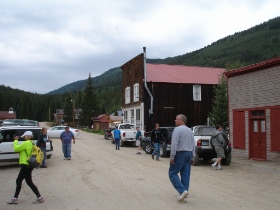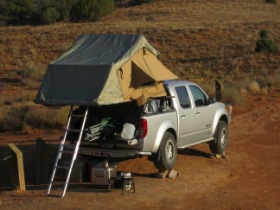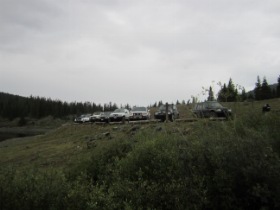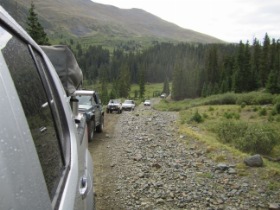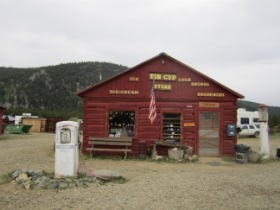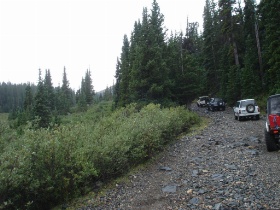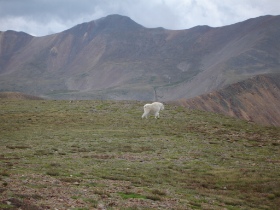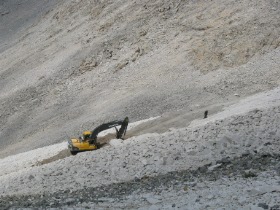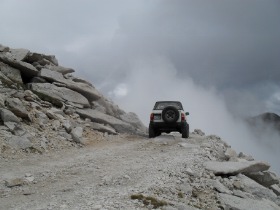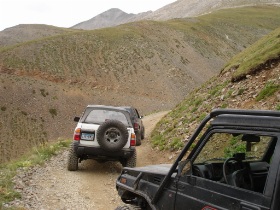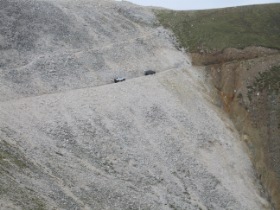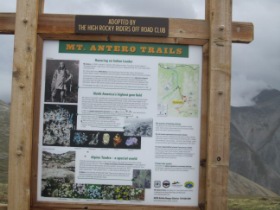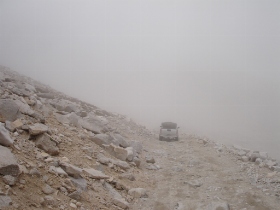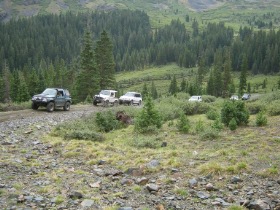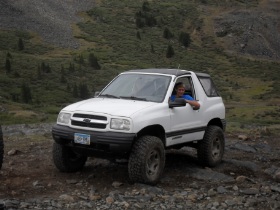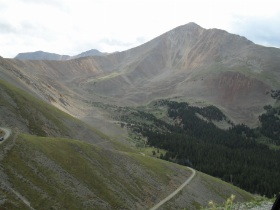Exploring the Tin Cup Pass Trail
ZUKIWORLD Online Travels To Colorado With Friends To Explore Colorado
Editor: Eric Bewley Photo: B. Savage, J. Verley, M. Verley, D. Horst, M. Hagen, S. Bewley, E. Bewley
Taylor Park, CO – Suzuki 4×4 enthusiasts from around the U.S. converged on a small reservoir in the beautiful state of Colorado to visit and explore this storied and wondrous area. The seed idea for this adventure was planted about two years earlier during ‘Zukfari when I had a conversation with Blake Savage about the interesting place he and some of his family would go to for summer vacations. The more he talked about it; the more I became interested in putting together and adventure. After bouncing emails and phone calls back and forth for a couple of months the plan was hatched and a date was set. Next stop would be Taylor Reservoir, Colorado.
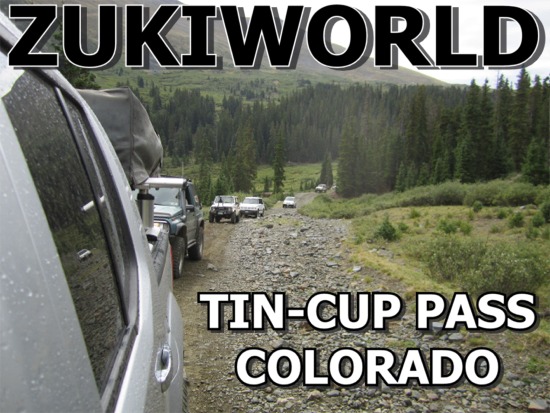
We had laid out a weeks worth of adventures at a BBQ meet and greet in Gunnison. I had coerced Blake into being a our fearless trail leader for most of the week and he had lined up a “greatest hits” of the trails he had been on over the years. We were going to do Tin Cup Pass, Mt. Antero, Italian Creek, Black Bear Pass and Schofield Pass. An ambitious week to say the least but we were ready for the miles. Ready, set…. GO!
First up was Tincup Pass. We met at the Taylor Park Reservoir store, restaurant, and gas station for a driver’s meeting. After a short talk about what we were going to do and common trail practices with a pep talk explaining that today we were going to be exposed to at least four things, fun… fun… fun… and a bit of sarcasm. The group of ten Suzuki headed out towards the trail on a cool and slightly rainy day that reminded us a lot of Oregon in the fall.
Connecting the tiny towns of Tincup1 and St. Elmo, this trail is a great way to get from Chaffee County to Gunnison County. It was not a particularly rocky or difficult road, but it did give the more stock vehicles a good challenge. DISCUSSION THREAD
We started on the Tincup side and after we went through the quaint and well visited town of Tincup we passed by Mirror Lake and we stopped there for the obligatory group shot. We crossed the creek and started heading uphill taking the easier path toward the top.
At the top of this pass, we all stopped for a break and a photo at the sign explaining how high we were and a little about the history of the area. Not the tallest pass we were going to do but my head was still pounding while we were there. I guess living at 400 feet has made me soft. Of interest to many of us four wheelers was a couple of period modified CJ3 jeeps. I got to give it to the two seventy to eighty year old couples that were driving them up this trail to go “jeepin'” they were definitely hard core.
Down the other side towards St. Elmo. This town is a very popular “ghost town” that has some shopping, ice-cream, attack hummingbirds, and some chipmunks that do not have the a firm grasp on what “personal space” means.
As some of us enjoyed some sightseeing around the town and a bit of that ice-cream, Hagen and his kids took a moment to feed those creepy little chipmunks. Seriously, they would climb all over you. Yeeuck! DISCUSSION THREAD
Our journey to Colorado was just as magnificent. We took many backroads and byways to get there and found a lot of unique and interesting road side attractions. One of which was the North end of Kokapelli’s trail which is on the Utah, Colorado Boarder close to I-70. This spot is over managed by the BLM but is still worth taking a look at.
Bright and early after an 80 degree evening.
Very mild trail with excellent scenery.
After exploring the town and having a bite of lunch, the group decided to split into two groups. Some wanted to start heading back on a more mild trail while part of the group was ready for the next adventure called Mt. Antero.
Mount Antero is one of Colorado’s mountains measuring over 14,000 feet. This particular mountain is special because you can drive to over 13,800 feet and then hike the rest of the way to the 14,269-foot summit. At is also rich in gemstones and semiprecious metals. If you can handle the elevation, this is a great place to look at and gather gemstones. Who knows, you may strike it rich?
 The trail itself is easy until you get very close to the top. A little scary as you are on a very narrow shelf road for most of the trip. There are many switchbacks and passing another vehicle is impossible in most places but we were lucky enough to only have to pass one Hummer, that’s all. We were above timberline when the switchbacks started so we could see just about everything, yes… everything.
The trail itself is easy until you get very close to the top. A little scary as you are on a very narrow shelf road for most of the trip. There are many switchbacks and passing another vehicle is impossible in most places but we were lucky enough to only have to pass one Hummer, that’s all. We were above timberline when the switchbacks started so we could see just about everything, yes… everything.
While we were driving up this trail I was thinking to myself about the Tincup pass trail and how that was a classic “Goat Trail” as Mike and Blake like to call it. A goat trail is just hard enough that you can’t go fast but not difficult enough to challenge. Well as we got to the top of this road, believe or not, we came over the crest of the ridge and low and behold there was a… sheep. Almost a goat, right? No matter because it was still cool to see one of those rare animals so close.
Driving on into the clouds we kept climbing and climbing until we reached the top when two interesting and unexpected things happened. First, everyone’s text and phone messages came in so there was a symphony of beeps and bzzzzes and then secondly we heard noises like we were in a construction zone. Yep, the classic beep beep beep and buck slam that is common were the big equipment is working. We walked over the ridge and looked down and there was an excavator cutting in a new road. That was neat but then we started thinking… How the heck did they drive that beast up here and who hauls the fuel for it? Logistically pretty interesting.
Out of breath and ready to head down. We loaded up and started back towards St. Elmo.
Day one was spectacular and long. We didn’t get back to camp until well after sunset but this trail and pace set the tone for the whole week. Our heads hit the pillow with unique visions and once in a life time experiences. I had to ask myself what was going to be in store for us. Yes, what’s next? … DISCUSSION THREAD
Tincup information – In October 1859, prospector Jim Taylor panned some gold from Willow Creek, and carried it back to camp in a tin cup; he named the valley Tin Cup Gulch.. For years the area was the site of seasonal placer mining, but no year-round communities were established, partly because of the danger of Indian attack. In 1878, lode deposits were discovered in the area, and the town of Virginia City was laid out in March 1879. By the 1880 census, the town had a population of 1,495. Virginia City was incorporated in August 1880, but confusion with Virginia City, Nevada, and Virginia City, Montana, caused the residents to change the name. The town was reincorporated in July 1882 as Tin Cup. Early Tin Cup was a violent place. Town marshal Harry Rivers died in a gunfight in 1882, and marshal Andy Jameson was shot to death in 1883. The town population declined when the mines were exhausted. The post office closed in 1918, and the last town election was held in 1918.
St. Elmo information – Originally named Forest City but was later changed because of the multitude of towns with the same name. The name St. Elmo was chosen by Griffith Evans, one of the founding fathers, who was reading a novel with the same title. The town was at its peak in the 1890s, when it included a telegraph office, general store, town hall, 5 hotels, saloons, dancing halls, a newspaper office, and a school house. The Denver, South Park and Pacific Railroad line ran through St. Elmo. There were 150 patented mine claims within the area. The majority of the people who lived in St. Elmo worked at the Mary Murphy, Teresa C., The Molly or the Pioneer Mines. The Mary Murphy Mine was the largest and most successful mine in the area. The Mary Murphy Mine recovered over $60,000,000 worth of gold while it was in operation. While the other mines eventually shut down, the Mary Murphy Mine continued to operate until the railroad was abandoned in 1922. Once the mining industry shut down, St. Elmo drastically declined in population. Miners searched elsewhere for gold and silver and the business district in St. Elmo closed down as well. Few people continued to live in the town. Postal service was discontinued in 1952 after the death of St. Elmo’s postmaster.
– The eleventh highest peak in Colorado, with an elevation of 14,276 feet (4,351 m). Also known as Antero Peak, it is named for Chief Antero of the Uintah band of Utes. It is located in the central Sawatch Range in Chaffee County between the towns of Buena Vista and Salida. The mountain itself is prized for its gemstone deposits and has one of the highest concentrations of aquamarine in the country. There are several active private mining claims on Mt. Antero and surrounding peaks. The peak was surveyed by the Pike Expedition in 1806. A forest service sign at the Browns Creek trailhead commemorates the expedition camp at the eastern base of the peak.

 ZUKIWORLD Online – Everything Suzuki Your Complete Suzuki Automotive Resource for Editorial, Tech, Events, Adventure, Racing, and Forum
ZUKIWORLD Online – Everything Suzuki Your Complete Suzuki Automotive Resource for Editorial, Tech, Events, Adventure, Racing, and Forum


